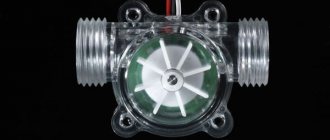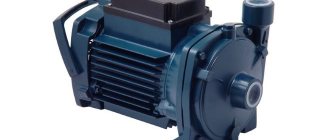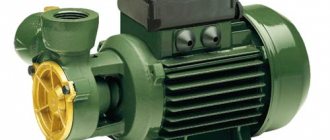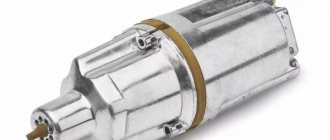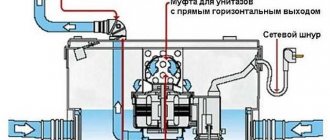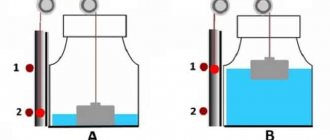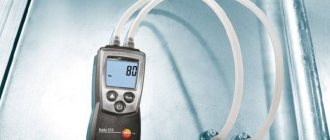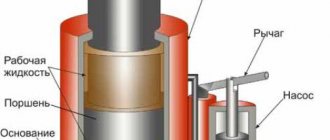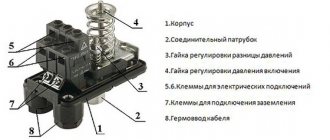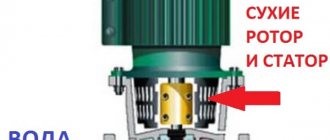To automate many production processes, it is necessary to monitor the water level in the tank; the measurement is carried out using a special sensor that gives a signal when the process medium reaches a certain level. It is impossible to do without level meters in everyday life; a striking example of this is the shut-off valve of a toilet cistern or an automatic system for shutting off a well pump. Let's look at the different types of level sensors, their design and operating principle. This information will be useful when choosing a device for a specific task or making a sensor yourself.
Various types of level sensors
Design and principle of operation
The design of measuring devices of this type is determined by the following parameters:
- Functionality, depending on this device, is usually divided into alarms and level meters. The former monitor a specific tank filling point (minimum or maximum), while the latter continuously monitor the level.
- The operating principle can be based on: hydrostatics, electrical conductivity, magnetism, optics, acoustics, etc. Actually, this is the main parameter that determines the scope of application.
- Measuring method (contact or non-contact).
In addition, the design features are determined by the nature of the technological environment. It is one thing to measure the height of drinking water in a tank, and another to check the filling of industrial wastewater tanks. In the latter case, appropriate protection is necessary.
Types of level sensors
Depending on the principle of operation, alarms are usually divided into the following types:
- float type;
- using ultrasonic waves;
- devices with a capacitive level detection principle;
- electrode;
- radar type;
- working on the hydrostatic principle.
Since these types are the most common, let's look at each of them separately.
Float
This is the simplest, but nevertheless effective and reliable way to measure liquid in a tank or other container. An example implementation can be found in Figure 2.
Rice. 2. Float sensor for pump control
The design consists of a float with a magnet and two reed switches installed at control points. Let us briefly describe the principle of operation:
- The container is emptied to a critical minimum (A in Fig. 2), while the float drops to the level where reed switch 2 is located, it turns on the relay that supplies power to the pump pumping water from the well.
- The water reaches the maximum level, the float rises to the location of reed switch 1, it is triggered and the relay is turned off, accordingly, the pump motor stops working.
It’s quite easy to make such a reed switch yourself, and setting it up comes down to setting on-off levels.
Note that if you choose the right material for the float, the water level sensor will work even if there is a layer of foam in the tank.
Ultrasonic
This type of meter can be used for both liquid and dry media and may have an analogue or discrete output. That is, the sensor can limit the filling upon reaching a certain point or monitor it continuously. The device includes an ultrasonic emitter, receiver and signal processing controller. The operating principle of the alarm is demonstrated in Figure 3.
Rice. 3. Operating principle of ultrasonic level sensor
The system works as follows:
- an ultrasonic pulse is emitted;
- the reflected signal is received;
- The duration of signal attenuation is analyzed. If the tank is full, it will be short (A Fig. 3), and as it becomes empty it will begin to increase (B Fig. 3).
The ultrasonic alarm is non-contact and wireless, so it can be used even in aggressive and explosive environments. After initial setup, such a sensor does not require any specialized maintenance, and the absence of moving parts significantly extends its service life.
Electrode
Electrode (conductometric) alarms allow you to monitor one or more levels of an electrically conductive medium (that is, they are not suitable for measuring the filling of a tank with distilled water). An example of using the device is shown in Figure 4.
Figure 4. Liquid level measurement with conductometric sensors
In the example given, a three-level alarm is used, in which two electrodes control the filling of the container, and the third is an emergency one to turn on the intensive pumping mode.
Capacitive
Using these alarms, it is possible to determine the maximum filling of the container, and both liquid and bulk solids of mixed composition can act as the process medium (see Fig. 5).
Rice. 5. Capacitive level sensor
The operating principle of the alarm is the same as that of a capacitor: the capacitance is measured between the plates of the sensitive element. When it reaches the threshold value, a signal is sent to the controller. In some cases, a “dry contact” design is used, that is, the level gauge operates through the tank wall in isolation from the process medium.
These devices can operate over a wide temperature range, are not affected by electromagnetic fields, and can operate over a long distance. Such characteristics significantly expand the scope of application up to severe operating conditions.
Radar
This type of alarm device can truly be called universal, since it can work with any process environment, including aggressive and explosive ones, and pressure and temperature will not affect the readings. An example of how the device works is shown in the figure below.
Level measurement with radar sensor
The device emits radio waves in a narrow range (several gigahertz), the receiver catches the reflected signal and, based on its delay time, determines how full the container is. The measuring sensor is not affected by pressure, temperature or the nature of the process fluid. Dustiness also does not affect the readings, which cannot be said about laser alarms. It is also necessary to note the high accuracy of devices of this type; their error is no more than one millimeter.
Hydrostatic
These alarms can measure both maximum and current filling of tanks. Their operating principle is demonstrated in Figure 7.
Figure 7. Fill measurement with gyrostatic sensor
The device is built on the principle of measuring the level of pressure produced by a column of liquid. Acceptable accuracy and low cost have made this type quite popular.
Within the scope of the article, we cannot examine all types of alarms, for example, rotary-flag ones, for identifying granular substances (a signal is sent when the fan blade gets stuck in a granular medium, after first tearing out the pit). It also makes no sense to consider the principle of operation of radioisotope meters, much less recommend them for checking the level of drinking water.
Functional characteristics of the main types
- The float sensor is a reliable and ergonomic design of the device, which is equipped with an electric level relay. The sensor works on the following principle: when the water level in the tank has reached a certain point, the liquid activates the float. By changing position, the float touches the relay and helps close the working contact.
Float devices are represented by magnetostrictive and discrete types. The first type is characterized by low cost and ease of operation, while the second type is characterized by high cost, complexity of installation and durability, guaranteeing precise control of the water level in the tank. The only drawback of float-type devices is their constant presence in a liquid medium.
- A hydrostatic sensor is a sensitive device for measuring water pressure in various containers. Its main advantages are durability, practicality, ergonomics and affordable cost.
Hydrostatic meters are constantly in contact with a liquid medium, so they are practically impossible to operate in aggressive conditions.
- The discrete sensor is represented by special plates that determine the degree of filling of containers with water. Structurally, such devices are devoid of moving elements and mechanisms, which ensures their durability, reliability and ease of use. Disadvantages of devices include mandatory contact with a liquid medium and susceptibility to changes in liquid temperature.
- The radar sensor controls the liquid level due to frequency shift, the difference between the emitting and reflecting signal. Such devices operate on the principle of an emitter and a collector of electromagnetic waves, due to which they provide more accurate measurements.
Radar-type devices have the following advantages:
- have a simple and reliable design;
- do not require contact with liquid medium;
- are resistant to aggressive environments;
- guarantee high results.
- The ultrasonic sensor is structurally and functionally similar to the previous type of device; monitoring is carried out using ultrasonic radiation, which is created by a special generator. It has the same advantages as its radar counterpart, the only difference is that the finished result is less accurate.
How to choose?
The choice of a water level sensor in a tank depends on many factors, the main ones:
- Composition of the liquid. Depending on the content of foreign impurities in the water, the density and electrical conductivity of the solution may change, which is likely to affect the readings.
- The volume of the tank and the material from which it is made.
- The functional purpose of the container is to accumulate liquid.
- The need to control the minimum and maximum level, or monitoring of the current state is required.
- Admissibility of integration into an automated control system.
- Switching capabilities of the device.
This is not a complete list for selecting measuring instruments of this type. Naturally, for domestic use it is possible to significantly reduce the selection criteria, limiting them to the volume of the tank, the type of operation and the control circuit. A significant reduction in requirements makes it possible to independently manufacture such a device.
Reed switch device
The main actuator element of the reed switch is the reed switch. The device is a small glass cylinder filled with an inert gas or with air evacuated. Gas or vacuum prevents the formation of sparks and oxidation of the contact group. Inside the flask there are closed contacts made of a ferromagnetic alloy of rectangular cross-section (permalloy wire) coated with gold or silver. When exposed to a magnetic flux, the contacts of the reed switch are magnetized and repel each other - the circuit through which the electric current flows opens.
Connection diagram for reed switch water level sensor
Reed switches are low power devices and are unable to switch high currents, so they cannot be used directly to turn a pump off and on. They are usually involved in the low-voltage switching circuit for the operation of a high-power pump relay located in the control cabinet.
The figure shows the simplest circuit with a sensor that controls the drainage pump depending on the water level during pumping, consisting of two reed switches SV1 and SV2.
When the liquid reaches the upper level, the magnet with the float turns on the upper reed switch SV1 and voltage is applied to the relay coil P1. Its contacts close, a parallel connection to the reed switch occurs and the relay is self-capturing.
The self-clipping function does not make it possible to turn off the power to the relay coil when the contacts of the switching button open (in our case it is the reed switch SV1). This happens if the relay load and its coil are connected to the same circuit.
Voltage is supplied to the coil of a powerful relay in the power supply circuit of the pump, its contacts close and the electric pump begins to work. When the water level drops and the float with the magnet of the lower reed switch SV2 reaches it, it turns on and a positive potential is also applied to the relay coil P1 on the other side, the current stops flowing and relay P1 turns off. This causes a lack of current in the coil of power relay P2 and, as a result, the supply voltage to the electric pump stops.
Rice. 6 Float vertical water level sensors
A similar pump control circuit, placed in the control cabinet, can be used when monitoring the level in a tank with liquid, if the reed switches are swapped, that is, SV2 will be at the top and turn off the pump, and SV1 in the depths of the water tank will turn it on.
Level sensors can be used in everyday life to automate the process when filling large containers with water using electric water pumps. The easiest types of reed switches to install and operate are those produced by industry in the form of vertical floats on rods and horizontal structures.
Making a water level sensor in a tank with your own hands
Let's say there is a task to automate the operation of a submersible pump for water supply to a dacha. As a rule, water flows into a storage tank, therefore, we need to make sure that the pump automatically turns off when it is filled. It is not at all necessary to buy a laser or radar level indicator for this purpose; in fact, you don’t need to purchase any. A simple problem requires a simple solution, it is shown in Figure 8.
Water pump control circuit
To solve the problem, you will need a magnetic starter with a 220-volt coil and two reed switches: a minimum level for closing, a maximum level for opening. The pump connection diagram is simple and, importantly, safe. The principle of operation was described above, but let’s repeat it:
- As the water collects, the float with the magnet gradually rises until it reaches the maximum level reed switch.
- The magnetic field opens the reed switch, turning off the starter coil, which leads to de-energization of the engine.
- As the water flows, the float drops until it reaches the minimum mark opposite the lower reed switch, its contacts close, and voltage is supplied to the starter coil, which supplies voltage to the pump. Such a water level sensor in a tank can work for decades, unlike an electronic control system.
A wide selection of liquid level sensors is offered - not only by the Russian manufacturer, but also by the exclusive representative of world-famous brands of instrumentation and equipment, the main of which is the American company Dwyer Instruments.
In the representative catalog of liquid level sensors, located at the link dwyer.ru/catalog/datchiki-urovnya, you can easily find a sensor of any type and level of complexity in stock or on order. These are hydrostatic, capacitive, float, vibration, reed switch and ultrasonic sensors, as well as directional wave radar. The company's offices are located in Moscow, St. Petersburg, Yekaterinburg, Kazan, Riga, Almaty. Contact numbers can be found on the website https://dwyer.ru. Makarov Dmitry
Main types of devices
Water level control sensors are classified according to their purpose. The devices are used to solve the following problems:
- control over changes in the liquid level in the container and alarm when the permissible value is exceeded;
- triggering a signaling sound or light relay in the central control unit;
- transferring measurements to the display of the control unit with determination of the containers used;
- maintaining a closed loop control over the liquid level in the container using a controller and an electric pump motor.
According to the design features, the device is:
- Non-contact type. Such devices are used for substances in viscous, granular, liquid or solid form. This category includes discrete and ultrasonic sensors.
- Contact type. Devices designed to be installed in a tank on the inner wall at an appropriate height. When the water reaches the set mark, the device is activated and a signal is transmitted. This category includes float and hydrostatic sensors.
According to the mechanism of action, the water level regulator in the tank is:
- float;
- hydrostatic;
- discrete;
- radar;
- ultrasonic
